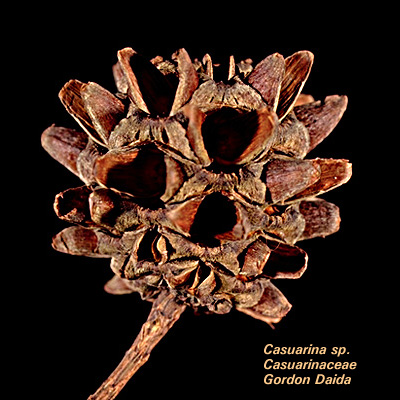Casuarinaceae
Hamamelidae: Casuarinales. The Casuarinaceae are monoecious or dioecious
trees and shrubs comprising one genus and about 50 species with green, jointed, whorled
photosynthetic branchlets. The leaves are minute and whorled. The male flowers are minute
and are clustered at the tips of branchlets in catkin-like strobili. Each flower consists
of a single stamen, a subtending bract and 2 pairs of bracteoles. The female flowers are
in ovoid clusters, each flower consists of a pistil, a subtending bract and two
bracteoles. The bicarpellate pistil has two long, filiform stigmas from a short style. The
ovary initially has two locules with two ovules in each but one locule is generally
completely aborted at anthesis. The bracts and bractlets enclosing the ovaries persist and
become woody, closely resembling a cone. Eventually, the bracts of individual flowers
separate, releasing the 1-seeded samaroid fruits.
Each "thumbnail" image below is linked to a larger photograph.
|
Casuarina equisetifolia, ironwood. Note the needle-like
photosynthetic branchlets and green, conelike fruiting structures. Just below these on the
center and right branches are about half a dozen tiny, reddish brown female
inflorescences. An elongated, cream-colored immature male inflorescence can be seen at the
tip of each of many of the branchlets on the left side of the top left photo. Near the top
of the top right photo is a developing cone-like fruiting structure. In the center a
female inflorescence that is just past anthesis still has some brown stigmas visible.
Whorls of tiny brown to pale yellow-green leaves may be seen at regular intervals along
the stems. In the lower photo, note the whorls of tiny leaves most clearly visible on the
two shoots with male flowers on the right. Each stamen represents a male flower. On the
left are two female inflorescences. Each female flower has a deeply 2-lobed red stigma. |
 |
Casuarina sp., ironwood. This photo shows a mature cone-like
fruiting structure. The fruits have been released through the openings created by
separation of the woody bracts and bracteoles. |
Flowering Plant Family Access Page
Home Page